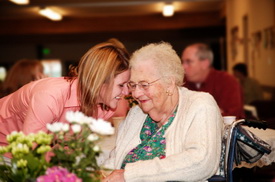From compassion may come great bitterness or anger. But with training in the experience of compassion, we can come to meet the pain with courage and without bitterness and anger.
(Editor’s Note: this essay is condensed, with permission, from a talk by Ani Pema Chodron recorded at Shambhala Mountain Center, October 1998. The 2 CD set is available as item 56-3 “Idiot Compassion” from Great Path Tapes & Books.)
Compassion is when, even in the face of great suffering, you remain in a state of loving-kindness without getting hard-hearted, shutting down or turning off. It is getting in touch with suffering and then experiencing a longing for the well-being of others. It may hurt but it gives you a connectedness feeling.
Compassion is a shared experience. The more you can stay with your own heart and your own experiences, the more you can stay feeling with other people. Compassion, and loving-kindness, grows from a lifetime of practice. From getting in touch with our inner compassion comes a sense of dissolving separateness, which is like experiencing complete openness.
If you can contact the love that you already feel, and in some way nurture it, then it will grow. The main way of nurturing is just to begin to notice it and acknowledge it. You can begin to notice it by watching a tear-jerking movie or turn on certain music that it brings out a longing or a sense of heart. My favorite is the Charlie Chaplin movie where he spends all day preparing for a party. Then he sits down and he sits and sits and nobody comes to the party. People watching the movie often have a good cry when Charlie cries.
From acknowledging your compassion can emerge a growing appreciation, a cherishing, of your ability to feel love and caring. We all have it, but it really is precious and needs to be nourished. Then it expands by itself. If you find yourself unable to feel compassion while doing an exercise in sending love to someone that has harmed you, don’t give up. It takes time and practice.
As you are sowing seeds and nourishing your capacity to love, you will from time to time notice an increment in your empathy and compassion. Instead of sowing seeds of negativity, be proud and glad of your progress little by little. The important progress is your growing confidence in your own good-heart.
Some ask, what is the point of living? The point is that it is your moment of opportunity. As you grow more and more you will gain a great sense of freedom. We have a choice in how we spend this life, and it can be toward more and more depression and unhappiness or toward greater warmth and joy. This is not to say that the path will be free of pain, but you can feel pain, love, even a kind of joy all at the same time.
I can tell you as someone who has been on this path for some time that with a growing confidence comes a kind of happiness and a sense of freedom from self-inflicted worry.
In these practices we get in touch with fear and pain, but equally important we get more familiar with compassion and happiness. Allow yourself that.
Compassion Practice
(after a period of quiet, sitting meditation) Today we will do the 5-step compassion practice. The five steps are summed up in these five slogans:
May [this sentient being] be free from suffering and the root of suffering.
May I be free from suffering and the root of suffering.
May [this close person] be free from suffering and the root of suffering.
May [this neutral person] be free from suffering and the root of suffering.
May [this difficult person] be free from suffering and the root of suffering.
It is best to start the first step with a person, sentient being or group whose suffering you can visualize from a concrete experience. Then say to yourself, “May [this person] be free from suffering and the root of suffering. Image the person (being or beings) to be completely free of suffering.
Then go on to the next step, which is to wish and imagine yourself to be free from suffering and the root of suffering.
You complete the practice by picturing three people and wishing each in turn to be free of suffering and the root of suffering. Starting with someone close, and then moving to someone with which you have a neutral relationship. Finally, you do the exercise imagining someone particularly difficult for you to accept, wishing and then imaging that person to be free of suffering and the root of suffering.
At each step, as your thoughts come up, be willing to feel the other’s suffering and for it to become a part of your suffering.
More details of the Compassion Practice can be found in Ani Pema Chodron’s web page article, “Compassion Practice“.
“The legacy of Pema Chodron’s teachings and Gampo Abbey may be supported through THE PEMA CHODRON FOUNDATION.


Comments